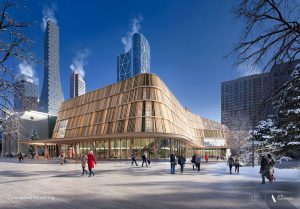TORONTO ‚Äî According to CBRE‚Äôs Q4 2023 ∫⁄¡œ≥‘πœÕ¯ Office Figures, the national downtown office vacancy rate hit a record high of 19.4 per cent in the final quarter of 2023, hampered by particularly soft demand in Toronto.
The city’s downtown office vacancy rate rose to 17.4 per cent from 15.8 per cent a quarter earlier largely due to new supply, with 624,550 square feet of new office space delivered in Q4 alone.
The 1.1 million of new office space constructed in 2023 contributed to the most negative net absorption Toronto has seen in a year since 2020: -2.7 million square feet, states a release, adding excluding Toronto, national net absorption of office space would have been positive in Q4 as improving demand for quality product and slowing new construction helped office fundamentals to improve in most cities.
Having introduced an office-to-residential conversion program, Calgary recorded its third consecutive quarter of positive net absorption of office space in Q4, pushing down its downtown vacancy to 30.2 per cent and Ottawa, which also had several successful office-to-residential conversions, saw downtown vacancy decline to 14.2 per cent.
More than 2.5 million square feet of office space (or 0.5 per cent of total inventory nationwide) was converted to mostly residential use in 2023, however, the number of feasible conversions remains limited due to physical requirements, zoning and financial viability.
According to the release, Vancouver, where no new office space has been delivered downtown over the past two quarters, recorded a dip in vacancy to 11 per cent in Q4 and Edmonton has had two quarters of positive net absorption and downtown office vacancy there dropped to 22.9 per cent in Q4. Halifax also recorded a dip in downtown vacancy to 17.9 per cent.
∫⁄¡œ≥‘πœÕ¯‚Äôs office development pipeline continues to thin, with only 10.9 million square feet under construction nationally which is the lowest construction total since Q3 2017. Only 784,000 square feet of office projects commenced construction in 2023.
‚ÄúThe office market continues to face challenges, but Toronto‚Äôs are particularly acute right now,‚Äù says CBRE ∫⁄¡œ≥‘πœÕ¯ Chairman Paul Morassutti in a statement. ‚ÄúBased on global trends, office utilization and demand are picking up. That is helping improve office fundamentals in most Canadian cities. Toronto will also benefit from the overall trends once new construction comes to an end since it is new supply that‚Äôs had the biggest impact on the city‚Äôs vacancy.‚Äù











Recent Comments
comments for this post are closed